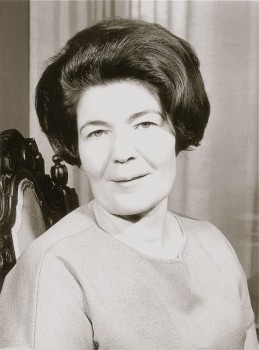Verse and freedom
16 January 2014 | Articles, Non-fiction

Aale Tynni (1913–1997). Photo: WSOY
Finnish poetic modernism, which with its freedom of rhythm came to dominate the literary mainstream of the 1950s, posed a particular challenge to the poets of the classical metrical and romantic poetic tradition. Aale Tynni (1913–1997) is not a poet of any one school or form, but rhythm is the deepest foundation of her poems, whether expressed in metre, free verse or the speech rhythms that characterise some of her poems of the 1950s and 60s, as well as those of her final years.
An Ingrian Finn, Tynni left Ingermanland near Petersburg for Finland as a refugee after the First World War, in 1919. The war and the period of uncertainty that followed it are present in her poems as an allegory, sometimes appearing as a dance of death or a carnival. At other times they emerge in the myth of Phaethon, who with his sun chariot is in danger of throwing Mother Earth off her axis, or as a game of chess in which God and the angel Gabriel play with the planets and moons as pieces. The poet makes use of mythic and cosmic references to widen her scope and to portray Man in the stages of history and the present age.
Aale Tynni was a poet of love; she portrays love in terms of natural imagery, sensations, emotions and spiritual experience. Her poems of the 1940s are about the poet’s vocation, patriotism, the family, maternal love, and the relationship between man and woman. She found effective poetic images for motherhood and even for the rarely depicted physical experiences of childbirth and breast-feeding.
In some of the poems the sense of confusion, expressed in metaphors, may be connected with the cultural pressures of the time and the change in society’s values. Tynni is also a poet of conviction. Her work evinces a belief that individual courage and protest matter, and that the views expressed by poems are important. In ‘Ballad of the importance of poetry’ the playing of an ordinary reed pipe on a market square reveals the secrets of the powerful. Myths and the visual arts can be used to reflect on modernism, as in the free verse poem ‘The fox climbs a wooded mountain’, a surrealistic study in perspectives.
Tynni’s work as a translator of world poetry, from the medieval European folksong through Shakespeare and the Edda to the French Modernists, helped her to maintain her own poetic profile. As a translator her goal was always to preserve contact with the rhythm of the original by imitating it and avoiding paraphrase.
The collection Ylitse vuoren lasisen (‘Over the glass mountain’, 1949) surprised many readers with its skilfully shifting rhythms and free use of ballad and story material. Tynni inflects the ballad, with its sorrow at the fortunes, passions and death of human beings, in many different ways. The poems are tinged with a humour that the contrast between verse and refrain often renders dark or absurd. Instead of writing conventional ballads, Tynni creates her own kind of poem in which only a thin thread, a title, a refrain or other pattern refers to the ballad form. In ‘Ballad of the miller’s son’ the well-known fairytale of Puss in Boots with its happy ending is gradually discharged in the tragic world of the ballad.
To mark the centenary of the birth of Aale Tynni an expanded edition of her Kootut runot (‘Collected poems 1938–1987’) and a biography entitled Aale Tynni. Hymyily, kyynel, laulu (‘Aale Tynni. A smile, a tear, a song’) were published in 2013 (WSOY). The elegant, frank biography is the work of Tynni’s daughter, Riitta Seppälä, and her grandson, Mikko-Olavi Seppälä, who have done much to revive the general reputation of a poet who was hitherto mainly known for her poem ‘Kaarisilta’ (‘The arch bridge’), an all-time favourite of radio poetry request programmes. The book discusses the life of the classic poet and academician in the context of the time and its conflicts.
Aale Tynni’s poems are marked by a rolling perspective of densely alternating sounds. The poetic ‘I’ contains an addressee, especially in the poems of yearning that Tynni produced in her old age, which are written to her dead husband, her soulmate. The collections Vihreys (’Verdancy’, 1979) and Vuodenajat (‘The seasons’, 1987) contain poems where the intuitive landscape of memories suggest the unmistakable presence of another person, as in ‘I don’t know if you’re there’.
The dialogue-like quality of the poems also has a basis in biography: Aale Tynni and P. Mustapää (the pseudonym of Martti Haavio [1899–1973] – they were married in 1960, each for the second time) were inspired, from the late 1940s onwards, by each other’s work. They wrote about their love for each other in poems that represent a secret lyrical conversation.
Translated by David McDuff
Tags: classics, literary history, poetry
No comments for this entry yet
